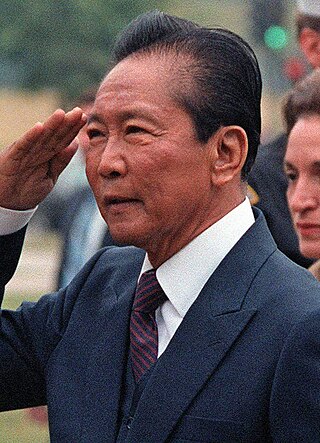
Ferdinand Emmanuel Edralin Marcos Sr. was a Filipino politician, lawyer, dictator, and kleptocrat who served as the tenth president of the Philippines from 1965 to 1986. He ruled under martial law from 1972 until 1981 and kept most of his martial law powers until he was deposed in 1986, branding his rule as "constitutional authoritarianism" under his Kilusang Bagong Lipunan. One of the most controversial leaders of the 20th century, Marcos' rule was infamous for its corruption, extravagance, and brutality.

Maria Corazon "Cory" Sumulong Cojuangco-Aquino was a Filipino politician who served as the eleventh president of the Philippines from 1986 to 1992. She was the most prominent figure of the 1986 People Power Revolution, which ended the two-decade rule of President Ferdinand Marcos and led to the establishment of the current democratic Fifth Philippine Republic.

The People Power Revolution, also known as the EDSA Revolution or the February Revolution, was a series of popular demonstrations in the Philippines, mostly in Metro Manila, from February 22 to 25, 1986. There was a sustained campaign of civil resistance against regime violence and electoral fraud. The nonviolent revolution led to the departure of Ferdinand Marcos, the end of his 20-year dictatorship and the restoration of democracy in the Philippines.

The Bataan Nuclear Power Plant (BNPP) is a nuclear power plant on the Bataan Peninsula, 100 kilometers (62 mi) west of Manila, Philippines. Completed but never fueled, it is located on a 3.57 km2 (1.38 sq mi) government reservation at Napot Point in Morong, Bataan. It was the Philippines' only attempt at building a nuclear power plant. It was mothballed due to safety concerns in the wake of the Chernobyl disaster in Ukraine in 1986 and issues regarding corruption. The Letter of Instruction No. 957, s. 1979 was signed by the late President Ferdinand Marcos and was published on November 13, 1979, in which it states that the continuation of the construction was not possible due to potential hazards to the health and safety of the public; however, the Marcos administration eventually supported the project.
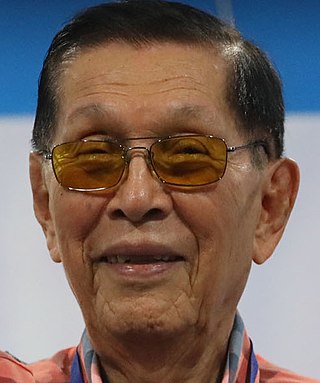
Juan Valentin Furagganan Ponce Enrile Sr.,, also referred to by his initials JPE, is a Filipino politician and lawyer known for his role in the administration of Philippine president Ferdinand Marcos; his role in the failed coup that helped hasten the 1986 People Power Revolution and the ouster of Marcos; and his tenure in the Philippine legislature in the years after the revolution. Enrile has served four terms in the Senate, in a total of twenty-two years, he holds the third longest-tenure in the history of the upper chamber. In 2022, at the age of 98, he returned to government office as the Chief Presidential Legal Counsel in the administration of Bongbong Marcos.

Gregorio "Gringo" Ballesteros Honasan II, is a Filipino politician and a cashiered Philippine Army officer who led unsuccessful coups d'état against President Corazon Aquino. He played a key role in the 1986 EDSA Revolution that toppled President Ferdinand Marcos.
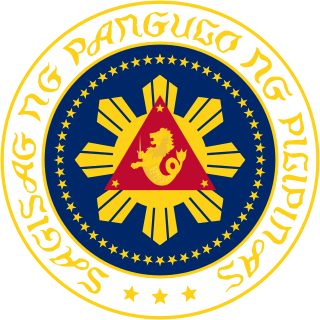
Proclamation No. 1081 was the document which contained formal proclamation of martial law in the Philippines by President Ferdinand Marcos, as announced to the public on September 23, 1972.

This article covers the history of the current Philippine republican state following the 1986 People Power Revolution, known as the Fifth Philippine Republic.

The history of the Philippines, from 1965 to 1986, covers the presidency of Ferdinand Marcos. The Marcos era includes the final years of the Third Republic (1965–1972), the Philippines under martial law (1972–1981), and the majority of the Fourth Republic (1981–1986). By the end of the Marcos dictatorial era, the country was experiencing a debt crisis, extreme poverty, and severe underemployment.

The Four Day Revolution is a 1988 Australian television film directed by Robert Markowitz and written by David Williamson. The story is about the journey and the love affair of an American foreign correspondent set during the final years of Ferdinand Marcos' dictatorship in the Philippines, from the assassination of Benigno Aquino Jr. in 1983 to the People Power Revolution in 1986, as well as other key events that led to the ouster of Marcos.
The anti-nuclear movement in the Philippines aimed to stop the construction of nuclear power facilities and terminate the presence of American military bases, which were believed to house nuclear weapons on Philippine soil. Anti-nuclear demonstrations were led by groups such as the Nuclear-Free Philippines Coalition (NFPC) and No Nukes Philippines. Coalitions argued that American bases in the Philippines perpetuated nuclear threats from other opponent nations of the United States, and that nuclear testing was transpiring in these bases. The nuclear threats and the bases also represented foreign intervention from the United States, which was a staunch issue among nationalists.
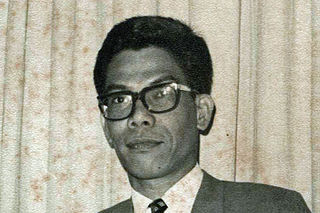
Guillermo Vinluan de Vega, nicknamed Gimo, was a presidential assistant of Philippine president Ferdinand E. Marcos with the rank of cabinet secretary. He was assassinated on October 27, 1975, while working at his office at the Malacañan Palace, the site of the president's residence and office complex.
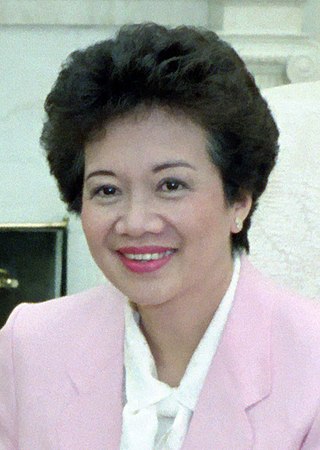
Corazon Aquino became the 11th President of the Philippines following the People Power Revolution or EDSA 1, and spanned a six-year period from February 25, 1986, to June 30, 1992. Aquino's relatively peaceful ascension to the Philippine presidency signaled the end of authoritarian rule of Ferdinand Marcos in the Philippines, and drew her and the Filipino people international acclaim and admiration.

Nuclear Energy was considered as an alternative source of energy after the 1973 oil crisis, in which the Philippines was affected. The Bataan Nuclear Power Plant was built in the early 1980s as a result, but never went into operation. It was mothballed by Former President Corazon Aquino on the fear of reactor meltdown after the Chernobyl Disaster as well as the increase of the price of the plant. The Fukushima nuclear disaster dampened further efforts to revive nuclear energy in the philippines and gave pause to efforts to revive the plant.
1972 in the Philippines details events of note that happened in the Philippines in the year 1972.

The Solid North refers to the regional voting bloc of the northern provinces of the Philippines for politicians of Ilocano descent, more particularly the Marcos family and their allies, and also economic issues affecting the Ilocanos in general such as the tobacco industry. Often included in Solid North are the provinces in the Ilocos Region, Cordillera Administrative Region (CAR), and Cagayan Valley. The regions are considered to be a conservative/right-wing bastion for the country.
Philippine Communications Satellite Corporation (PHILCOMSAT) is a telecommunications company based in Makati, Metro Manila, Philippines. Its main teleport is in the province of Rizal.
Certain associates of former Philippine President Ferdinand Marcos, historically referred to using the catchphrase "Marcos cronies", benefited from their friendship with Marcos – whether in terms of legal assistance, political favors, or facilitation of business monopolies, during his administration. Marcos critics, and the local and international press began referring to these individuals as "cronies" during the latter days of the Marcos dictatorship, and the Philippine government – especially the Presidential Commission on Good Government (PCGG) – continued using the term after the ouster of Marcos in 1986.
Historical distortion regarding Ferdinand Marcos is a political phenomenon in the Philippines. Ferdinand Marcos was the country's president between 1965 and 1986. Distortion, falsification, or whitewashing of the historical record regarding this period, sometimes referred to using the phrases "historical denialism", "historical negationism", or "historical revisionism" as a euphemism for negationism, is an academically documented phenomenon linked to the return of Marcos' immediate family and political allies to government positions, as well as the hero's burial of Marcos himself in 2016. It continues Marcos' own efforts to create a cult of personality for himself, which in itself involved various forms of historical distortion.
The alleged September 22, 1972, ambush attack on the then-Defense Minister of the Philippines Juan Ponce Enrile is a disputed incident in which Enrile's white Mercedes-Benz sedan was ambushed near the upscale Wack Wack village in Mandaluyong, Metro Manila. It was cited by President Ferdinand Marcos as the proximate incident which led to the announcement of Marcos' declaration of martial law the following day, although Marcos would later claim that he signed the formal proclamation of martial law on September 21, the day before the Enrile ambush.















